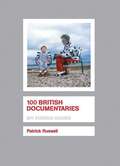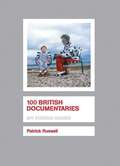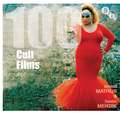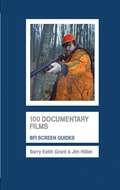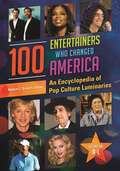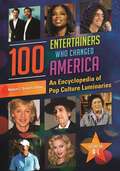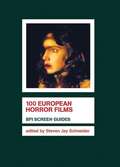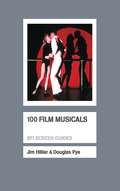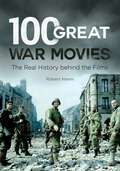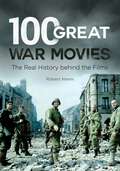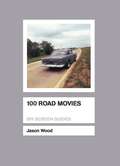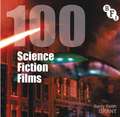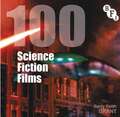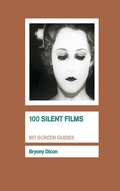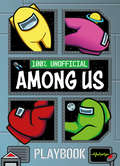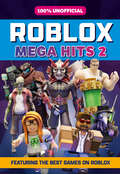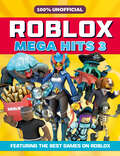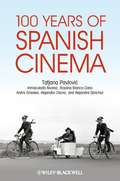- Table View
- List View
100 British Documentaries: Bfi Screen Guides (Screen Guides)
by Patrick RussellEver since John Grierson popularized the term 'documentary,' British non-fiction film has been renowned, sometimes reviled, but seldom properly appreciated. '100 British Documentaries 'provides a uniquely accessible, occasionally provocative introduction to a rich and surprisingly varied tradition by considering 100 examples taken from across a century's worth of output. The 100 films range from the Victorian period to the present day. Alongside such classics as 'Night Mail 'and 'Touching the Void 'are documentaries that illustrate the many uses to which it has been put from pro-gram-filler to political propaganda to classroom teaching aid and the many styles and viewpoints it has embraced. While the focus is on the documentary 'film,' several television productions are included, indicating how the genre has developed on the small screen.
100 British Documentaries (Screen Guides)
by Patrick RussellEver since John Grierson popularized the term 'documentary,' British non-fiction film has been renowned, sometimes reviled, but seldom properly appreciated. '100 British Documentaries 'provides a uniquely accessible, occasionally provocative introduction to a rich and surprisingly varied tradition by considering 100 examples taken from across a century's worth of output. The 100 films range from the Victorian period to the present day. Alongside such classics as 'Night Mail 'and 'Touching the Void 'are documentaries that illustrate the many uses to which it has been put from pro-gram-filler to political propaganda to classroom teaching aid and the many styles and viewpoints it has embraced. While the focus is on the documentary 'film,' several television productions are included, indicating how the genre has developed on the small screen.
100 Cult Films (Screen Guides)
by Ernest Mathijs Xavier MendikSome films should never have been made. They are too unsettling, too dangerous, too challenging, too outrageous and even too badly made to be let loose on unsuspecting audiences.Yet these films, from the shocking Cannibal Holocaust to the apocalyptic Donnie Darko, from the destructive Tetsuo to the awfully bad The Room, from the hilarious This Is Spinal Tap to the campy Showgirls, from the asylum of Das Cabinet des Dr. Caligari to the circus of Freaks, from the gangs of The Warriors to the gangsters of In Bruges and from the flamboyant Rocky Horror Picture Show to the ultimate cool of The Big Lebowski, have all garnered passionate fan followings.Cult cinema has made tragic misfits, monsters and cyborgs, such as Edward Scissorhands or Blade Runner's replicants, heroes of our times. 100 Cult Films explains why these figures continue to inspire fans around the globe. Cult film experts Ernest Mathijs and Xavier Mendik round up the most cultish of giallo, blaxploitation, anime, sexploitation, zombie, vampire and werewolf films, exploring both the cults that live hidden inside the underground (Nekromantik, Café Flesh) and the cult side of the mainstream (Dirty Dancing, The Lord of the Rings, and even The Sound of Music).100 Cult Films is a true trip around the world, providing a lively and illuminating guide to films from more than a dozen countries, across nine decades, representing a wide range of genres and key cult directors such as David Cronenberg, Terry Gilliam and David Lynch. Drawing on exclusive interviews with some of the world's most iconic cult creators and performers, including Dario Argento, Pupi Avati, Alex Cox, Ruggero Deodato, Jesús Franco, Lloyd Kaufman, Harry Kümel, H. G. Lewis, Christina Lindberg, Takashi Miike, Franco Nero, George A. Romero and Brian Yuzna, and featuring a foreword by cult director Joe Dante, 100 Cult Films is your ultimate ticket to the midnight movie show.
100 Documentary Films (Screen Guides)
by Barry Keith Grant Jim HillierDocumentary films constitute a major part of film history. Cinema's origins lie, arguably, more in non-fiction than fiction, and documentary represents the other - often submerged and barely visible - 'half' of cinema history. Historically, documentary cinema has always been an important point of reference for fiction cinema, and the two have often overlapped. Over the last two decades, documentary cinema has enjoyed a revival in critical and commercial success.100 Documentary Films is the first book to offer concise and authoritative individual critical commentaries on some of the key documentary films - from the Lumière brothers and the beginnings of cinema through to recent films such as Bowling for Columbine and When the Levees Broke - and is global in perspective. Many different types of documentary are discussed, as well as films by major documentary directors, including Robert Flaherty, Humphrey Jennings, Jean Rouch, Dziga Vertov, Errol Morris, Nick Broomfield and Michael Moore. Each entry provides concise critical analysis, while frequent cross reference to other films featured helps to place films in their historical and aesthetic contexts.Barry Keith Grant is Professor of Film Studies and Popular Culture at Brock University, Ontario, Canada. He is the author of Film Genre: From Iconography to Ideology (2007), Voyages of Discovery: The Cinema of Frederick Wiseman (1992) and co-author, with Steve Blandford and Jim Hillier, of The Film Studies Dictionary (2001).Jim Hillier is Visiting Lecturer in Film at the University of Reading. He is the author of The New Hollywood (1993), the co-author of The Film Studies Dictionary (2001) and, with Alan Lovell, of Studies in Documentary (1972). His edited books include American Independent Cinema (2001) and two volumes of the English translation of the selected Cahiers du cinema (1985, 1986).
100 Entertainers Who Changed America [2 volumes]: An Encyclopedia of Pop Culture Luminaries [2 volumes]
by Robert C. SickelsThis fascinating and thought-provoking read challenges readers to consider entertainers and entertainment in new ways, and highlights figures from outside the worlds of film, television, and music as influential "pop stars."Comprising approximately 100 entries from more than 50 contributors from a variety of fields, this book covers a wide historical swath of entertainment figures chosen primarily for their lasting influence on American popular culture, not their popularity. The result is a unique collection that spotlights a vastly different array of figures than would normally be included in a collection of this nature—and appeals to readers ranging from high school students to professionals researching specific entertainers.Each subject individual's influence on popular culture is analyzed from the context of his or her time to the present in a lively and engaging way and through a variety of intellectual approaches. Many entries examine commonly discussed figures' influence on popular culture in ways not normally seen—for example, the widespread appeal of Woody Allen's essay collections to other comedians; or the effect of cinematic adaptations of Tennessee Williams' plays in breaking down Hollywood censorship.
100 Entertainers Who Changed America [2 volumes]: An Encyclopedia of Pop Culture Luminaries [2 volumes]
by Robert C. SickelsThis fascinating and thought-provoking read challenges readers to consider entertainers and entertainment in new ways, and highlights figures from outside the worlds of film, television, and music as influential "pop stars."Comprising approximately 100 entries from more than 50 contributors from a variety of fields, this book covers a wide historical swath of entertainment figures chosen primarily for their lasting influence on American popular culture, not their popularity. The result is a unique collection that spotlights a vastly different array of figures than would normally be included in a collection of this nature—and appeals to readers ranging from high school students to professionals researching specific entertainers.Each subject individual's influence on popular culture is analyzed from the context of his or her time to the present in a lively and engaging way and through a variety of intellectual approaches. Many entries examine commonly discussed figures' influence on popular culture in ways not normally seen—for example, the widespread appeal of Woody Allen's essay collections to other comedians; or the effect of cinematic adaptations of Tennessee Williams' plays in breaking down Hollywood censorship.
100 European Horror Films (Screen Guides)
by Steven Jay SchneiderFrom bloodsucking schoolgirls to flesh-eating zombies, and from psychopathic killers to beasts from hell, '100 European Horror Films' provides a lively and illuminating guide to a hundred key horror movies from the 1920s to the present day. Alongside films from countries particularly associated with horror production - notably Germany, Italy, and Spain and movies by key horror filmmakers such as Mario Bava, Dario Argento, and Lucio Fulci, '100 European Horror Films' also includes films from countries as diverse as Denmark, Belgium, and the Soviet Union, and filmmakers such as Bergman, Polanski and Claire Denis, more commonly associated with art cinema. The book features entries representing key horror subgenres such as the Italian 'giallo' thrillers of the late 60s and 70s, psychological thrillers, and zombie, cannibal, and vampire movies. Each entry includes a plot synopsis, major credits, and a commentary on the film's significance, together with its production and exhibition history. Films covered in the book include early classics such as Paul Wegener's 'The Golem,' Robert Wiene's 'The Cabinet of Dr. Caligari,' and 'Murnau's Nosferatu'; 70s horror favorites such as 'Daughters of Darkness, The Beast,' and 'Suspiria'; and notable recent releases such as 'The Devil's Backbone, Malefique,' and 'The Vanishing.'
100 European Horror Films (Screen Guides)
From bloodsucking schoolgirls to flesh-eating zombies, and from psychopathic killers to beasts from hell, '100 European Horror Films' provides a lively and illuminating guide to a hundred key horror movies from the 1920s to the present day. Alongside films from countries particularly associated with horror production - notably Germany, Italy, and Spain and movies by key horror filmmakers such as Mario Bava, Dario Argento, and Lucio Fulci, '100 European Horror Films' also includes films from countries as diverse as Denmark, Belgium, and the Soviet Union, and filmmakers such as Bergman, Polanski and Claire Denis, more commonly associated with art cinema. The book features entries representing key horror subgenres such as the Italian 'giallo' thrillers of the late 60s and 70s, psychological thrillers, and zombie, cannibal, and vampire movies. Each entry includes a plot synopsis, major credits, and a commentary on the film's significance, together with its production and exhibition history. Films covered in the book include early classics such as Paul Wegener's 'The Golem,' Robert Wiene's 'The Cabinet of Dr. Caligari,' and 'Murnau's Nosferatu'; 70s horror favorites such as 'Daughters of Darkness, The Beast,' and 'Suspiria'; and notable recent releases such as 'The Devil's Backbone, Malefique,' and 'The Vanishing.'
100 Exercises to Get You Into Drama School: Improve your acting and audition skills
by Jona Howl'The book's main asset is its clarity and accessibility, it relates to its readers in a helpful and clear way.' John Gillett, actor trainer and author of Acting on ImpulseCompetition for drama school is fierce, thousands apply every year for only a few places. Preparing well for your audition is key.This book gives drama-school hopefuls the inside track only previously available via professional coaches. It gives clear advice on improving acting skills through effective exercises in which voice, movement, text and character come together with a single aim: to pass that elusive audition and get your career off the ground.Content and acting workshops include: posture, movement, the Alexander Technique, voice, how to work with the text, how to prepare for the Big Day, how to behave on the day. A resource section for places of study is also included.With specific exercises designed by a top London drama school coach, this book will help you think and feel like an actor. Get into training for auditions in film, TV or theatre today!
100 Film Musicals (Screen Guides)
by Douglas Pye Jim HillierFrom the coming of sound to the 1960s, the musical was central to Hollywood production. Exhibiting – often in spectacular fashion – the remarkable resources of the Hollywood studios, musicals came to epitomise the very idea of 'light entertainment'. Films like Top Hat and 42nd Street, Meet Me in St. Louis and On the Town, Singin' in the Rain and Oklahoma!, West Side Story and The Sound of Music were hugely popular, yet were commonly regarded by cultural commentators as trivial and escapist. It was the 1970s before serious study of the Hollywood musical began to change critical attitudes and foster an interest in musical films produced in other cultures. Hollywood musicals have become less common, but the genre persists and both academic interest in and fond nostalgia for the musical shows no signs of abating. 100 Film Musicals provides a stimulating overview of the genre's development, its major themes and the critical debates it has provoked. While centred on the dominant Hollywood tradition, 100 Film Musicals includes films from countries that often tried to emulate the Hollywood style, like Britain and Germany, as well as from very different cultures like India, Egypt and Japan. Jim Hillier and Douglas Pye also discuss post-1960s films from many different sources which adapt and reflect on the conventions of the genre, including recent examples such as Moulin Rouge! and High School Musical, demonstrating that the genre is still very much alive.
100 Great War Movies: The Real History behind the Films
by Robert J. NiemiThis book serves as a fascinating guide to 100 war films from 1930 to the present. Readers interested in war movies will learn surprising anecdotes about these films and will have all their questions about the films' historical accuracy answered.This cinematic guide to war movies spans 800 years in its analysis of films from those set in the 13th century Scottish Wars of Independence (Braveheart) to those taking place during the 21st-century war in Afghanistan (Lone Survivor). World War II has produced the largest number of war movies and continues to spawn recently released films such as Dunkirk. This book explores those, but also examines films set during such conflicts as the Napoleonic Wars, the American Civil War, World War I, the Vietnam War, and the wars in Afghanistan and Iraq.The book is organized alphabetically by film title, making it easy to navigate. Each entry is divided into five sections: Background (a brief discussion of the film's genesis and financing); Production (information about how, where, and when the film was shot); Synopsis (a detailed plot summary); Reception (how the film did in terms of box office, awards, and reviews) and "Reel History vs. Real History" (a brief analysis of the film's historical accuracy). This book is ideal for readers looking to get a vivid behind-the-scenes look at the greatest war movies ever made.
100 Great War Movies: The Real History behind the Films
by Robert J. NiemiThis book serves as a fascinating guide to 100 war films from 1930 to the present. Readers interested in war movies will learn surprising anecdotes about these films and will have all their questions about the films' historical accuracy answered.This cinematic guide to war movies spans 800 years in its analysis of films from those set in the 13th century Scottish Wars of Independence (Braveheart) to those taking place during the 21st-century war in Afghanistan (Lone Survivor). World War II has produced the largest number of war movies and continues to spawn recently released films such as Dunkirk. This book explores those, but also examines films set during such conflicts as the Napoleonic Wars, the American Civil War, World War I, the Vietnam War, and the wars in Afghanistan and Iraq.The book is organized alphabetically by film title, making it easy to navigate. Each entry is divided into five sections: Background (a brief discussion of the film's genesis and financing); Production (information about how, where, and when the film was shot); Synopsis (a detailed plot summary); Reception (how the film did in terms of box office, awards, and reviews) and "Reel History vs. Real History" (a brief analysis of the film's historical accuracy). This book is ideal for readers looking to get a vivid behind-the-scenes look at the greatest war movies ever made.
100 Road Movies (Screen Guides)
by Jason WoodIn '100 Road Movies', each entry will offer an insightful critique in terms of aesthetics, plot structure and defining formal and thematic features, whilst also considering the title in the wider context and understanding of by what criteria a film may be considered a road movie. Full credits, including year of production, principal cast and technical crew and country of origin will also be included at the foot of each entry. There will be a selection of illustrative stills, approximately twenty-five in total. The scope is broad, a consideration of the elements that gave rise to the road movie sub-genre, how this sub-genre corresponds to other traditional genres (the thriller, the western etc) and how various international countries have adopted the road movie to reflect their cultural, social, political and geographical identities.
100 Road Movies (Screen Guides)
by Jason WoodIn '100 Road Movies', each entry will offer an insightful critique in terms of aesthetics, plot structure and defining formal and thematic features, whilst also considering the title in the wider context and understanding of by what criteria a film may be considered a road movie. Full credits, including year of production, principal cast and technical crew and country of origin will also be included at the foot of each entry. There will be a selection of illustrative stills, approximately twenty-five in total. The scope is broad, a consideration of the elements that gave rise to the road movie sub-genre, how this sub-genre corresponds to other traditional genres (the thriller, the western etc) and how various international countries have adopted the road movie to reflect their cultural, social, political and geographical identities.
100 Science Fiction Films (Screen Guides)
by Barry Keith GrantA comprehensive guide to science fiction films, which analyzes and contextualizes the most important examples of the genre, from Un voyage dans la lune (1902), to The Road (2009).
100 Science Fiction Films (Screen Guides)
by Barry Keith GrantA comprehensive guide to science fiction films, which analyzes and contextualizes the most important examples of the genre, from Un voyage dans la lune (1902), to The Road (2009).
100 Shakespeare Films (Screen Guides)
by Daniel RosenthalFrom Oscar-winning British classics to Hollywood musicals and Westerns, from Soviet epics to Bollywood thrillers, Shakespeare has inspired an almost infinite variety of films. Directors as diverse as Orson Welles, Akira Kurosawa, Franco Zeffirelli, Kenneth Branagh, Baz Luhrmann and Julie Taymor have transferred Shakespeare's plays from stage to screen with unforgettable results. Spanning a century of cinema, from a silent short of 'The Tempest' (1907) to Kenneth Branagh's 'As You Like It' (2006), Daniel Rosenthal's up-to-date selection takes in the most important, inventive and unusual Shakespeare films ever made. Half are British and American productions that retain Shakespeare's language, including key works such as Olivier's 'Henry V' and 'Hamlet', Welles' 'Othello' and 'Chimes at Midnight', Branagh's 'Henry V' and 'Hamlet', Luhrmann's 'Romeo + Juliet' and Taymor's 'Titus'. Alongside these original-text films are more than 30 genre adaptations: titles that aim for a wider audience by using modernized dialogue and settings and customizing Shakespeare's plots and characters, transforming 'Macbeth' into a pistol-packing gangster ('Joe Macbeth' and 'Maqbool') or reimagining 'Othello' as a jazz musician ('All Night Long'). There are Shakesepeare-based Westerns ('Broken Lance', 'King of Texas'), musicals ('West Side Story', 'Kiss Me Kate'), high-school comedies ('10 Things I Hate About You', 'She's the Man'), even a sci-fi adventure ('Forbidden Planet'). There are also films dominated by the performance of a Shakespearean play ('In the Bleak Midwinter', 'Shakespeare in Love'). Rosenthal emphasises the global nature of Shakespearean cinema, with entries on more than 20 foreign-language titles, including Kurosawa's 'Throne of Blood and Ran', Grigori Kozintsev's 'Russian Hamlet' and 'King Lear', and little-known features from as far afield as 'Madagascar' and 'Venezuela', some never released in Britain or the US. He considers the films' production and box-office history and examines the film-makers' key interpretive decisions in comparison to their Shakespearean sources, focusing on cinematography, landscape, music, performance, production design, textual alterations and omissions. As cinema plays an increasingly important role in the study of Shakespeare at schools and universities, this is a wide-ranging, entertaining and accessible guide for Shakespeare teachers, students and enthusiasts.
100 Shakespeare Films (Screen Guides)
by Daniel RosenthalFrom Oscar-winning British classics to Hollywood musicals and Westerns, from Soviet epics to Bollywood thrillers, Shakespeare has inspired an almost infinite variety of films. Directors as diverse as Orson Welles, Akira Kurosawa, Franco Zeffirelli, Kenneth Branagh, Baz Luhrmann and Julie Taymor have transferred Shakespeare's plays from stage to screen with unforgettable results. Spanning a century of cinema, from a silent short of 'The Tempest' (1907) to Kenneth Branagh's 'As You Like It' (2006), Daniel Rosenthal's up-to-date selection takes in the most important, inventive and unusual Shakespeare films ever made. Half are British and American productions that retain Shakespeare's language, including key works such as Olivier's 'Henry V' and 'Hamlet', Welles' 'Othello' and 'Chimes at Midnight', Branagh's 'Henry V' and 'Hamlet', Luhrmann's 'Romeo + Juliet' and Taymor's 'Titus'. Alongside these original-text films are more than 30 genre adaptations: titles that aim for a wider audience by using modernized dialogue and settings and customizing Shakespeare's plots and characters, transforming 'Macbeth' into a pistol-packing gangster ('Joe Macbeth' and 'Maqbool') or reimagining 'Othello' as a jazz musician ('All Night Long'). There are Shakesepeare-based Westerns ('Broken Lance', 'King of Texas'), musicals ('West Side Story', 'Kiss Me Kate'), high-school comedies ('10 Things I Hate About You', 'She's the Man'), even a sci-fi adventure ('Forbidden Planet'). There are also films dominated by the performance of a Shakespearean play ('In the Bleak Midwinter', 'Shakespeare in Love'). Rosenthal emphasises the global nature of Shakespearean cinema, with entries on more than 20 foreign-language titles, including Kurosawa's 'Throne of Blood and Ran', Grigori Kozintsev's 'Russian Hamlet' and 'King Lear', and little-known features from as far afield as 'Madagascar' and 'Venezuela', some never released in Britain or the US. He considers the films' production and box-office history and examines the film-makers' key interpretive decisions in comparison to their Shakespearean sources, focusing on cinematography, landscape, music, performance, production design, textual alterations and omissions. As cinema plays an increasingly important role in the study of Shakespeare at schools and universities, this is a wide-ranging, entertaining and accessible guide for Shakespeare teachers, students and enthusiasts.
100 Silent Films (Screen Guides)
by Bryony Dixon100 Silent Films provides an authoritative and accessible history of silent cinema through one hundred of its most interesting and significant films. As Bryony Dixon contends, silent cinema is not a genre; it is the first 35 years of film history, a complex negotiation between art and commerce and a union of creativity and technology. At its most grand – on the big screen with a full orchestral accompaniment – it is magnificent, permitting a depth of emotional engagement rarely found in other fields of cinema. Silent film was hugely popular in its day, and its success enabled the development of large-scale film production in the United States and Europe. It was the start of our fascination with the moving image as a disseminator of information and as mass entertainment with its consequent celebrity culture. The digital revolution in the last few years and the restoration and reissue of archival treasures have contributed to a huge resurgence of interest in silent cinema. Bryony Dixon's illuminating guide introduces a wide range of films of the silent period (1895–1930), including classics such as The Birth of a Nation (1915), The General (1926), Metropolis (1927), Sunrise (1927) and Pandora's Box (1928), alongside more unexpected choices, and represents major genres and directors of the period – Griffith, Keaton, Chaplin, Murnau, Sjöström, Dovzhenko and Eisenstein – together with an introductory overview and useful filmographic and bibliographic information.
100% Unofficial Among Us Playbook
by FarshoreThere’s a parasitic shapeshifter on the loose and it’s your job to work out who it is.
100% Unofficial Roblox Mega Hits 3
by 100% UnofficialOVER 15 MORE OF ROBLOX’S BEST GAMES INSIDE FOR YOU TO EXPLORE
100 Westerns (Screen Guides)
by Edward BuscombeAddresses the perennial appeal of the Western, exploring its 19th century popular culture, and its relationship to the economic structure of Hollywood. This work considers the defining features of the Western and traces its main cycles, from the epic Westerns of the 1920s and singing cowboys of the 1930s to the Spaghetti Westerns of the 1960s.
100 Westerns (Screen Guides)
by Edward BuscombeAddresses the perennial appeal of the Western, exploring its 19th century popular culture, and its relationship to the economic structure of Hollywood. This work considers the defining features of the Western and traces its main cycles, from the epic Westerns of the 1920s and singing cowboys of the 1930s to the Spaghetti Westerns of the 1960s.
100 Years of Spanish Cinema
by Tatjana Pavlović Inmaculada Alvarez Rosana Blanco-Cano Anitra Grisales Alejandra Osorio Alejandra Sánchez100 Years of Spanish Cinema provides an in-depth look at the most important movements, films, and directors of twentieth-century Spain from the silent era to the present day. A glossary of film terms provides definitions of essential technical, aesthetic, and historical terms Features a visual portfolio illustrating key points of many of the films analyzed Includes a clear, concise timeline to help students quickly place films and genres in Spain’s political, economical, and historical contexts Discusses over 20 films including Amor Que Mata, Un Chien Andalou, Viridana, El Verdugo, El Crimen de Cuenca, and Pepi, Luci, Born
